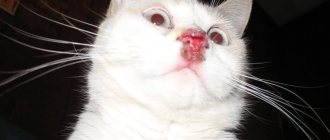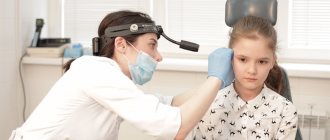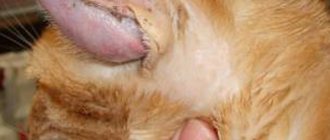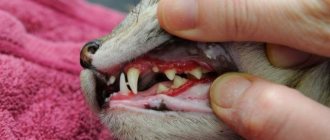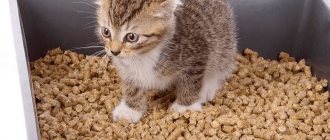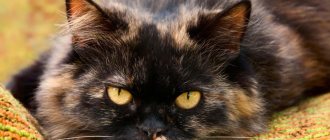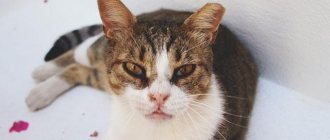Is nasal discharge a cause for concern?
If your cat's sneezing and/or nasal discharge is minor and she has a normal appetite and activity level, you just need to monitor her condition. To be on the safe side, it is better to isolate a cat with a “running” nose from other animals.
Chronic nasal discharge is a common symptom of viral and bacterial infections and should be taken seriously. However, most often, nasal discharge is associated with food or seasonal allergies.
Prevention
The pet is protected from irritants - dust, tobacco smell, perfumes. Provide balanced nutrition. If a felinologist does not have the skills to prepare a diet from natural products, it is better to use factory-made food. To avoid contracting cat flu, your pet is vaccinated in a timely manner.
Multifel-4
Discharge of clear fluid from the nose indicates that a foreign object has entered the nostrils, an allergic reaction, or a contagious disease. If an alarming symptom occurs, contact a veterinarian. You cannot treat the disease yourself with human medications, as well as folk remedies.
We invite you to join our Zen channel and group on VKontakte or Odnoklassniki, where new articles for pet owners are published.
Similar articles:
- My cat has a nosebleed - what should I do?
- Inflammation of the lower lip in a cat
- Papillomas and warts in cats
Allergic rhinitis in cats
If you observe watery discharge accompanied by sneezing, it usually means your cat has ingested or inhaled an allergen from the environment. Allergies to non-food irritants, also known as atopy, were most likely inherited by your cat from her parents.
Note! Atopic allergy is an increased sensitivity to common allergens: plants and their waste products, mold, insect bites and dust mites, etc.
Nasal congestion: how to help your cat
A method to help a cat breathe better, also used by us humans, is to use water vapor to help remove mucus.
Obviously, you should not place your cat's head on a bowl of hot water, as the cat may get burned or scalded if it hits the basin. But it would be enough to prepare a steam bath by turning on the hot water of the shower and allowing the cat to enter the steamy environment for 10 minutes, keeping it away from the water.
Additionally, although the cat's nose is blocked, it is necessary to clear it by soaking a cotton swab and running it under the cat's nose. Finally, you need to contact your veterinarian, who will decide whether to subject your furry friend to antibacterial therapy or prescribe a mucolytic drug.
Viral or respiratory diseases in cats
Thick and mucous discharge is a sign of a respiratory infection. It is important to understand that there are a lot of such infections and the diagnosis must be made by a veterinarian.
Viral diseases of cats that cause rhinitis:
- Actinomycosis.
- Viral peritonitis.
- Hemobartonellosis.
- Viral immunodeficiency.
- Calicivirus.
- Giardiasis.
- Mycoplasmosis.
- Panleukopenia (distemper).
- Parvovirus.
- Rhinotracheitis or herpes virus infection.
- Chlamydia.
A bacterial infection can cause chronic nasal discharge. If the discharge is thick, yellow and has an unpleasant odor - a bacterial infection, this is the most likely diagnosis.
Kitten's nose is stuffy
Kittens, due to unformed immunity and weakened resistance, are susceptible to various viral-bacterial and parasitic diseases. Various pathogenic microorganisms, viruses, fungi, and protozoa can provoke illness in small pets. Infection of kittens occurs transplacentally, during intrauterine development, if the mother cat suffers from an infectious disease or is a latent virus carrier.
Nasal congestion in a kitten can be caused by hypothermia, allergies, severe helminthic infestation, and the presence of foreign objects in the nasopharynx and nasal passages.
Progression of chronic rhinitis
Regardless of whether the infection is viral or bacterial, the first discharge is watery and thin, and after 24–72 hours it becomes thicker, colored, and may acquire an unpleasant odor. In advanced stages of the disease, purulent discharge is observed.
Common causes of sneezing and chronic rhinitis in cats:
- Upper respiratory tract infection.
- Allergies or irritation of mucous membranes, for example, from smoke, dust, cleaning products, air fresheners, household chemicals.
- Diseases of the oral cavity and teeth.
- Foreign object in the nasal passage, polyps, neoplasms.
The cause of nasal discharge that periodically appears and goes away may be worms. Moreover, there are parasites whose eggs mature in the respiratory tract. The larvae hatch and begin to move, which irritate the respiratory tract, causing coughing, nasal discharge, sneezing and general malaise.
Secondary chronic rhinitis in cats
Cats are created to be unique and versatile. Wild animals keep their senses and teeth constantly clean. Domestic cats receiving an adapted diet do not have this opportunity. It is for this reason that more than 80% of cats over the age of 6 suffer from:
- Caries.
- Tartar.
- Various gum diseases.
Dental problems are a common cause of chronic nasal discharge in cats. Contact your veterinarian if you observe the following symptoms:
- Careful chewing or refusal to eat.
- Salivation.
- "Champing."
- Unpleasant odor from the mouth.
- Discharge from the eyes.
- Cough.
- Temperature increase.
- Ulcerative gum disease.
Another alarming symptom is noisy breathing through the mouth. Most often, open-mouth breathing indicates complete blockage of the nostrils. A similar picture can be observed when:
- Nasal congestion.
- Reporting.
- Neoplasms, including polyps.
Nasal infections can affect both your cat's overall health and her sense of smell. Nasal infections of a viral and bacterial nature can be “identified” by the following symptoms:
- Sneezing.
- Souring of the eyes.
- Refusal of food.
- Fever.
- A sharp decrease in activity.
Copious nasal discharge is observed with the following viral diseases:
- Herpes.
- Rhinotracheitis.
- Plague.
Note! Nasal discharge may be the first symptom of conjunctivitis, as the mucous membranes of the eyes and nose “communicate.”
Causes
Transparent nasal discharge is a reflex reaction of the body to cleanse itself of the following irritants:
- Infectious – viruses, pathogenic bacteria, helminth larvae.
- Non-infectious - foreign objects and allergens.
If fluid comes out of one nostril, it means a mechanical object has entered it. In case of an allergic irritant, both nasal openings remove dust or block access to the mucous membrane of unpleasant-smelling substances - perfumes, gasoline, tobacco. If you remove the object or interrupt the contact of the cat's nose with the irritant, the discharge will stop.
Rhinitis
Otherwise, pay attention to additional signs. They indicate a contagious disease.
If, in addition to nasal discharge, lacrimation or conjunctival hyperemia occurs, contact a specialist. The probable cause of the pathology is cat flu. Unvaccinated young animals, elderly individuals or those weakened by chronic illnesses suffer.
In what cases is the help of a veterinarian needed?
- Sneezing and nasal discharge for 3 or more days.
- Intensive deterioration of the condition - the cat sneezes more often, the nose runs more strongly.
- The color and/or consistency of nasal discharge changes.
- Green, yellow, black, or bloody nasal discharge.
- Itching in the muzzle area.
- Noisy or hoarse breathing, snoring.
- Decreased appetite and activity level.
- Vomit.
- Photophobia.
- Fever.
- Anemia of the mucous membranes.
- Noticeable deterioration in wool quality.
- The appearance of crusts, cracks, scabs on the skin of the nose.
- Discharge from the eyes.
Treatment at home
What to do if the kitten can’t breathe through its nose? How to treat it correctly? Even if your pet has mild nasal congestion and other symptoms of the disease, it is necessary to establish an accurate diagnosis, and only a veterinarian can do this. The first thing to rule out is infectious diseases. They tend to develop very quickly, often after contact with other people's animals, accompanied by other symptoms. Depending on the cause, a course of treatment will be prescribed.
Course of antibiotics
Seizures in a cat: causes, what to do, treatment
In case of an infectious disease, the cat is prescribed a course of antibiotics. The medication is continued until the end, otherwise the likelihood of the infection returning and the occurrence of chronic inflammation of the nasal mucosa increases. In addition, your veterinarian may also prescribe antipyretics and anti-inflammatory drugs.
Rinse and inhalation
What should you do if your cat’s nose is clogged and he grunts, and treatment progresses very slowly? To speed up the healing process, it is recommended to use rinsing, inhalation with essential oils and moisturizing the nose with baby cream.
Vasoconstrictor drops
If a cat grunts when breathing and has quite severe nasal congestion, she is prescribed drops for a runny nose - a vasoconstrictor drug with an immunostimulating effect. Typically, such medications are prescribed for a period of up to 1 week.
Important! Only drops specifically designed for cats are allowed to be instilled. It is better not to exceed the recommended dosages.
During the treatment period, the cat should drink plenty of warm water and eat only warm food. If an animal refuses to eat, you should purchase food that has a richer aroma.
Vasoconstrictor drops should be purchased only those intended for pets
Medications should be purchased taking into account the age of the animal. For example, kittens are prohibited from taking medications that are intended for adults. Even if the drug is for children, it is important to ensure that the dosage is maintained. If there is an excess of drugs in the body, the pet may begin to experience side effects.
To remove nasal discharge, use a cotton pad or swab. The procedure must be carried out with extreme care, otherwise if the mucous membrane is damaged, the condition will only worsen. If the discharge is abundant and the cat is noticeably sniffling, then the nose should be rinsed with boiled water or saline solution. In this case, you should use a pipette or syringe without a needle.
Diagnostic methods
Rhinitis is diagnosed by nasal congestion, discharge and sneezing. Diagnosing the root causes is becoming more difficult:
- You need to collect a complete medical history, which is almost impossible if you adopted a cat from a shelter or adopted it on the street.
- If the symptomatic picture and tests are not enough, the veterinarian conducts a full examination (the cat is first placed under anesthesia).
During the examination, the veterinarian must ensure that:
- The cat does not have congenital defects in the structure of the skull and nose.
- There is no fistula in the septum between the nose and mouth.
- There are no foreign objects in the cat's nose.
Because nasal congestion can be caused by swelling and injury, your doctor may recommend an X-ray or MRI.
Runny nose in cats and why you shouldn’t use nose drops
Cat lovers often encounter or have heard about this problem. “The cat is sneezing!”, “the cat is sniffling!”, “can’t breathe through its nose!”, “some kind of discharge from the nose...” and so on. All these complaints can be combined into one medical term - rhinitis (inflammation of the nasal mucosa). Owners, by analogy with people, say: “I have a cold,” but in fact, in animals everything is much more complicated... A constantly stuffy nose reduces the activity of the animal, due to the loss of smell, appetite worsens, the “taste for life” disappears, so to speak, and some pathologies, accompanied by rhinitis, can even lead to death.
Because rhinitis is not a separate disease, but just a symptom. The task of the doctor and owner is to try to find the cause of rhinitis. Anamnesis (animal medical history, information from the owner), tests and hardware diagnostics can help with this. How to sort through the heap of proposed tests and examinations? It is sometimes difficult even for doctors, but there are points that need to be known.
Colds, we must remember once and for all: there is no such term! Yes, against the background of hypothermia, the protective properties of the immune system may decrease: the animal is more susceptible to viruses and bacteria. But warm-blooded animals have a constant body temperature, which can only be lowered by extreme conditions (falling through the ice, prolonged fasting, dehydration, toxins, blood loss, etc.), but not by an open window or a cold floor.
The main causes of rhinitis in cats:
- Viral diseases . Most often these are calicivirus and feline herpesvirus or infectious rhinotracheitis (IRT). Usually these viruses are not fatal, but they “spoil the blood” of owners and doctors due to their characteristics.
Calicivirus - causes ulcers in the oral cavity, mucous membranes of the lips, nose, causes rhinitis, in rare cases - pneumonia, lameness, skin lesions. The peculiarity of this virus is that it mutates very quickly, so vaccination, unfortunately, does not fully protect against the disease, that is, it protects, but only against the strains (varieties) that are included in the vaccine. To identify calicivirus, the doctor takes a scraping from the oral cavity with a special brush or cotton swab. The procedure is not painful.
Herpes virus (HRT) is a virus that affects 80-90% of the cat population and is transmitted at an early age from the mother. In small kittens it is accompanied by eye damage, in adult cats - by rhinitis. Kittens can even go blind, so treatment cannot be delayed! The peculiarity of this virus is that after the symptoms subside, the herpes virus goes to live in the nervous tissue (trigeminal nerve). And therefore, in some cats, under stress (the arrival of a new family member or pet, moving, repair work), RTI may again become active. Unfortunately, laboratory diagnosis is difficult: swabs from mucous membranes do not always reveal the virus; the cornea or trigeminal nerve is more informative. Due to their invasiveness, such tests are not relevant in practice.
Sometimes owners themselves infect their pets. Veterinarians regularly hear a story: they adopted a kitten that looked healthy, but the house cat got sick. Why is this happening? Because a kitten that has recovered from a viral disease sheds the virus for another 20 days. A newly arrived cat should be separated, ideally to another home. If the possibility is limited only to the provision of a separate room, then when in contact with a sick animal or carrier, gloves, shoe covers, a robe should be used, and all things should be removed when leaving the room.
Treatment consists of rinsing the nose, mouth, eyes, prescribing painkillers and, possibly (prescribed by a doctor), antibiotics. Antibiotics do not kill viruses, they are needed to suppress a secondary infection, which is never the root cause! Sometimes a doctor may prescribe a drug that suppresses the reproduction of herpesvirus, but usually, symptomatic treatment is sufficient. The effectiveness of immunostimulants has not been proven. But there are additional interferences that prevent the immune system from coping with infections. This is feline viral leukemia and immunodeficiency. They affect the very heart of the body - the immune system, so a cat suffering from leukemia or immunodeficiency simply cannot effectively cope with other, less dangerous viruses, despite the diligence of the doctor and owner. Chronic viral infections, also called viral leukemia and immunodeficiency, are difficult to diagnose, so several samples of material are required over a certain period of time.
- Foreign body in the nasal cavity . It seems like how could it get there? And, nevertheless, if you constantly observe discharge from one nostril, you definitely need to do a rhinoscopy. During rhinoscopy, the foreign body will be immediately removed and the cat will recover. It is very disappointing to hear cases where owners decided to undergo rhinoscopy after 2 years of useless treatment, and it turned out that a blade of grass was stuck in the nasal passages. Why don't people want to have rhinoscopy? Because it is a financial burden and anesthesia. The fear of anesthesia dates back to “ancient” times, when there were no veterinary anesthesiologists. In the era of modern equipment and the narrow focus of specialists, there is an anesthesiologist in every clinic, and even more so where rhinoscopy is performed. Obviously, no one wants to pay extra money, but if there are objective indications for rhinoscopy, you shouldn’t delay.
- In older cats, spontaneous discharge from this nostril may be due to a tumor of the nasal sinuses or ear . polyps are sometimes found in young cats . The diagnosis can be confirmed using MRI (soft tissue involvement), CT (bone structures). For the same reason as rhinoscopy, owners do not want to do these studies, very in vain: after all, while the tumor is small, it can be successfully removed, which is not always possible in advanced cases.
- An allergic reaction is extremely rare. Allergies that are accompanied by rhinitis occur at certain times of the year. Small particles such as construction dust can be irritating and cause rhinitis and cough.
- Also, the culprits of a runny nose are teeth and ears. The affected roots of the teeth serve as a source of infection, while the crowns of the teeth that we see may look healthy. For the most part, this is a pathology of older cats (after 10 years). The dentist determines the condition of the roots of the teeth by taking a dental x-ray under sedation . Pus in the middle ear sometimes causes signs of a respiratory infection. There is no way to defeat it with antibiotics; the source of infection must be removed. Diagnostics - otoscopy in the clinic, CT, MRI in complex cases.
So, we’ve come to the main question: WHY YOU SHOULD NOT PUT DROPS INTO A CAT’S NOSE. As you can see, due to a variety of reasons, this is simply not effective. There are no drops that can cure a tumor or reach a foreign body and cope with the virus. They are also not effective in humans. It’s just that the drops reduce the swelling and it seems to us that things are getting better. However, in cats, due to the anatomical shape of the nostrils, drops hardly penetrate. Perhaps most drops do not harm, but by dripping into your pet’s nose, reassuring yourself that you are treating without diagnosing, you are wasting the animal’s precious time.
A few words about treatment.
1. The doctor should tell you approximately when improvement will occur; if it does not, a repeat visit to the veterinary clinic is needed.
- Some drops can be used after rhinoscopy for 3 days to relieve swelling. If used for longer, even greater swelling of the nasal mucosa is possible.
- If there is heavy thick discharge, nasal rinsing is prescribed in the clinic. If regular rinsing does not help, and the discharge is thick, sometimes it is rinsed under sedation (for this you can use 2 liters of saline, with the obligatory installation of a tracheal tube). If the doctor looks at your request with round eyes and a slightly open mouth, go to another clinic.
- Search for the reason. No matter how you want it, you have to! If your runny nose miraculously went away and you treated it with drops, it’s just a coincidence. Without eliminating the cause, after 7 days of taking it, rhinitis will return.
- Follow your doctor's orders, especially antibiotic therapy. Tell your doctor honestly if you have not given or are not going to give antibiotics. You should not change the antibiotic yourself; you should think about changing it if there is no effect after 7 days of use. Another antibacterial drug is usually selected based on culture results.
- In case of illness of the oral cavity, pharynx and a number of other reasons, when the animal does not eat for a long time and force-feeding is impossible, it is better to insert an esophageal tube. A very convenient thing, especially for the animal.
- If the cat suffers from chronic rhinitis (chronic viral infections, herpes virus, seasonal allergies) or after rhinoscopy, you should not spray any aerosols on it or smoke. During repairs, isolate from dust. These actions will prevent exacerbation and worsening of symptoms.
And remember: doctors without the support of the owner will not be able to cure the animal!
Health to you and your animals!
